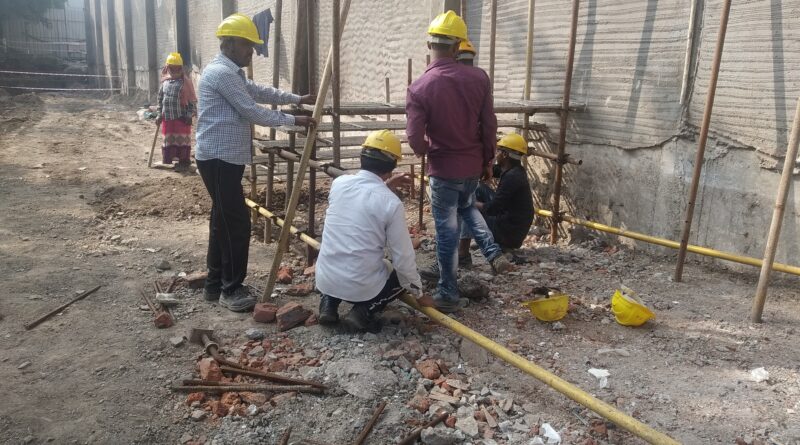site Engineer interview question |Practical knowledge
What do you know about bar bending schedule ?
Bar bending schedule is a document that provides details of reinforcement steel bars, their shape, size, length, and quantity required for construction.
- It is used by civil engineers and contractors for estimating the amount of steel required for a construction project.
- It includes information about the diameter, length, and shape of each bar, as well as the number of bars required for each section of the structure.
- It helps in reducing wastage of steel and ensures that the reinforcement is placed correctly in the structure.
- It is an important document for ensuring the safety and durability of the structure.
- For example, a bar bending schedule for a bridge would include details of the steel bars required for the foundation, piers, beams, and deck of the bridge.
How to calculate concrete quantity in structure to ready for casting ?
Calculating concrete quantity for a structure
- Determine the volume of the structure to be filled with concrete
- Calculate the required concrete mix ratio
- Multiply the volume by the mix ratio to get the total concrete quantity
- Add an extra 5-10% to account for wastage and spillage
- Consider the type of structure and its intended use when selecting the mix ratio
What is steel density ?
Steel density is the mass per unit volume of steel.
- Steel density is typically measured in kilograms per cubic meter (kg/m³).
- The density of steel can vary depending on the alloy and composition.
- The density of mild steel is around 7.85 g/cm³.
- High-strength low-alloy (HSLA) steel can have a density of up to 8.05 g/cm³.
- Stainless steel has a density of around 8 g/cm³.
What is load bearing and friction pile ?
Load bearing piles support the weight of the structure while friction piles transfer the load to the soil through friction.
- Load bearing piles are designed to support the weight of the structure and transfer it to the soil below.
- Friction piles rely on the friction between the pile and the soil to transfer the load to the ground.
- Load bearing piles are commonly made of concrete or steel while friction piles are usually made of timber or concrete.
- Examples of load bearing piles include driven piles, drilled piles, and screw piles while examples of friction piles include timber piles and belled piles.
What are the layers of road ?
The layers of a road include subgrade, subbase, base, and surface course.
- Subgrade: natural soil or improved soil beneath the pavement
- Subbase: layer of aggregate material placed on top of the subgrade
- Base: layer of asphalt or concrete placed on top of the subbase
- Surface course: top layer of asphalt or concrete that provides a smooth riding surface
What is the leaping length ?
Leaping length is the distance between two consecutive supports of a bridge or a beam.
- Leaping length is also known as span length.
- It is an important factor in the design of bridges and beams.
- The leaping length determines the maximum load that the structure can bear.
- For example, a bridge with a leaping length of 50 meters can bear heavier loads than a bridge with a leaping length of 30 meters.
How many test of concrete ?
There are several tests conducted on concrete to ensure its quality and strength.
- Some common tests for concrete include compressive strength test, slump test, and water absorption test.
- Compressive strength test measures the maximum load a concrete sample can bear before failure.
- Slump test measures the consistency and workability of fresh concrete.
- Water absorption test determines the amount of water absorbed by concrete over time.
- Other tests may include durability tests, chloride penetration test, and air content test.
Calculate CBR value of soil ?
CBR value of soil can be calculated by conducting a CBR test.
- CBR stands for California Bearing Ratio.
- It is a measure of the strength of soil.
- The test involves measuring the pressure required to penetrate a soil sample with a plunger.
- The CBR value is expressed as a percentage of the pressure required to penetrate a standard material.
- Higher CBR values indicate stronger soil.
- CBR values are used in designing pavement thickness and evaluating subgrade strength.
Difference Between Concrete Cube Testing Reading Variation ?
Concrete cube testing reading variation refers to the difference in strength readings obtained from testing different samples of the same concrete mix.
- Concrete cube testing is done to determine the strength of the concrete mix.
- Variations in readings can occur due to factors such as differences in sample preparation, curing conditions, and testing equipment.
- It is important to ensure consistency in testing procedures to obtain accurate and reliable results.
- For example, if one cube is tested at 28 days and another at 30 days, the readings may vary due to differences in curing time.
- Variations in readings can also occur due to human error in handling and testing the samples.
How many type of bench mark ?
There are three types of benchmarks in civil engineering: primary, secondary, and tertiary.
- Primary benchmarks are permanent reference points with known elevations.
- Secondary benchmarks are temporary points established for a specific project.
- Tertiary benchmarks are intermediate points used for leveling between primary and secondary benchmarks.
- Examples of primary benchmarks include survey monuments and geodetic control points.
- Examples of secondary benchmarks include construction stakes and temporary leveling rods.
- Examples of tertiary benchmarks include intermediate leveling rods and temporary benchmarks.

